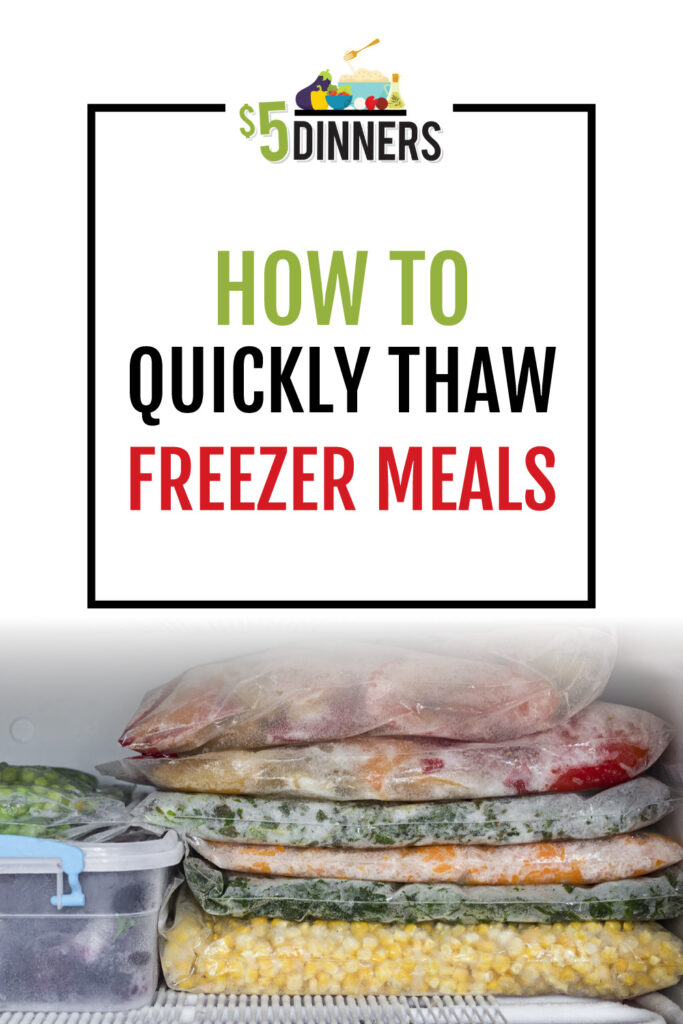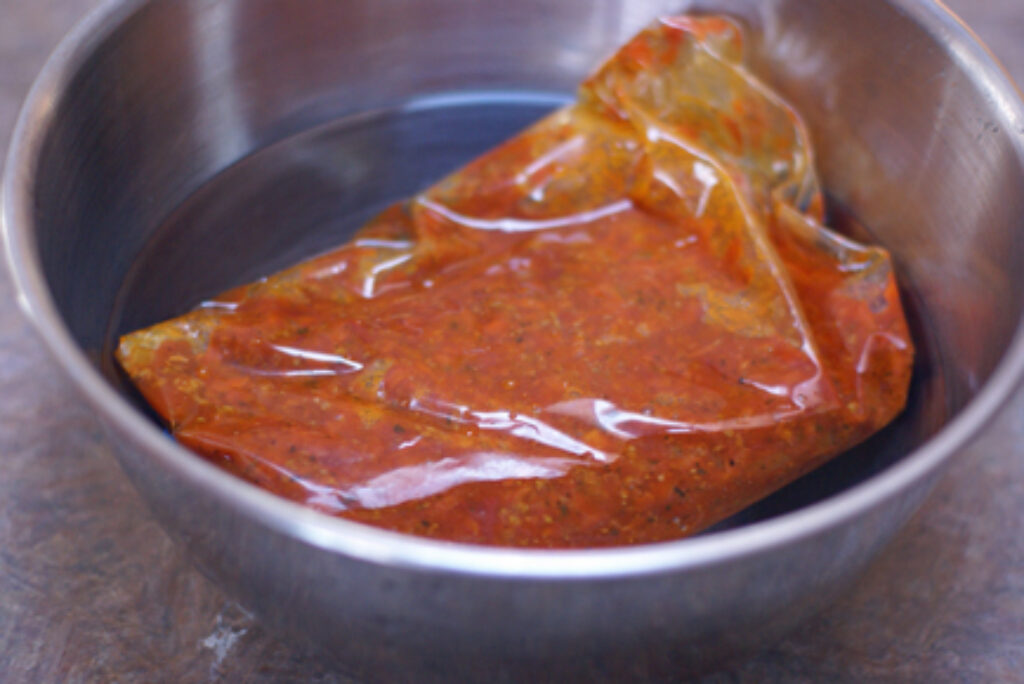During the past few weeks of my $35/week pantry challenge, I have been on a mission to use up all the ingredients, sauces and other goodies from the pantry and freezer. Last week I planned to use up the part of my Chunky Bolognese Sauce that I’d made back in October. I had every intention of pulling the sauce from the freezer the night before and putting it into the fridge, giving it plenty of time to thaw out.
But life happened. It slipped my mind. And come dinner prep hour, I found myself in a pinch.
Thankfully, there is a quick and painless way to thaw sauces, soups, and other cooked frozen goodies…if you need them quickly. Simply, place the frozen item into a large bowl with warm (not crazy hot) water and let it sit for a bit…30-45 minutes, maybe longer…depending on how thick the largest part is. Sauces or soups that are frozen “horizontally” or “flattened” will thaw very quickly, as there is less space to have to warm through.
(If you are thawing raw meats using this method, keep the bowl with the warm water in the fridge. Obviously the water will cool, but it will thaw faster than if you just let it thaw on the plate.)
And there you have it…quick thawing 101.



Julie says
I never thaw stuff ahead unless it’s a large turkey or ham. Everything gets put in the microwave on auto defrost. It does a great job fairly quickly. I am thankful for the microwave…if not for it my family wouldn’t eat b/c the meat would still be frozen! lol
Tricia says
If you have a nonstick griddle or grilling pan you can use it as a defrosting tray. I don’t know how it works, but it’s amazing how quickly stuff thaws on them!
Karen says
Or if you have a bit more time and a cast iron skillet, lay the package of frozen food on the skillet. This even works for fairly thick, solid items like chicken breasts. You can speed things up a bit by running the pan under hot water (the underside, then dry). It’s conductivity that does it. I actually found one of those cast aluminum defrosting plates (they used to be advertised on tv) at a thrift store, still in the box, for $.99 and use it for most of my thawing. A nice big discounted, then frozen steak will thaw for summer barbeques in about an hour. Any heavy metal surface will work. I used to use my microwave for last minute rush things, but found it tended to half cook thinner edges of things. Maybe its just my microwave, but I like this way better, and it uses no power.
Anne says
The fastest and SAFEST (from a food pathogen perspective) way is to thaw things in cold water that is moving. I put what needs thawing in its container in a bowl, fill it with cold water and then turn the water down so it just barely drizzles. Alton Brown explained the mechanism of why this works faster than warm water, I don’t remember. But I do remember that it is not safe to use warm or hat water to thaw, as it provides a lovely temperature for bacteria to breed. Here is the USDA page about safe thawing: http://www.fsis.usda.gov/factsheets/big_thaw/index.asp
Karen says
Me again. I was trying to remember the brand name of my defrosting tray and could not, but did find an identical looking one online which is called a Thaw Easy Defrost Tray, or Miracle Thaw. I also found a listing of thaw times using a cast aluminum griddle at http://www.allamerican-chefsdesign.com. Anne left a link to the USDA regarding safe thawing and I think the points made there should definitely be heeded. I also think that the thaw times given at the All American site are short enough to be safe. That being said, I also think it is important to remember not to leave defrosting foods on the counter and go out to pick up milk. This is a quick process, and I am usually in the kitchen almost the whole time getting the rest of the meal preparations done. When the meat is defrosted, the tray is very cold, having transferred the cold from the food to the tray the same way a pan transfers heat from a stove element. I also tend to package foods for freezing in flat packages which do thaw faster, and can be broken into smaller pieces while they are still partially frozen. That way I can put a flat pack of precooked ground beef on the tray to thaw, put a pot of water on to boil for pasta, and by the time it is boiling, I can break the beef into small pieces inside the freezer bag and start the sauce. I initially suggested a cast iron skillet because it works the same way and it is likely that more people would have one. Whichever way you choose, don’t leave any defrosting/defrosted food at room temperature. Refrigerate or cook immediately.
Briana Ford says
I do this all the time. In fact, that picture is exactly what my process looks like. I think it’s more efficient than putting things in the microwave, and I almost never burn myself in the process.